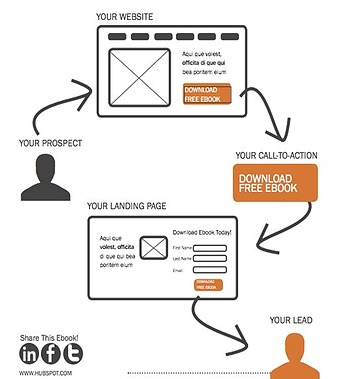 For most companies introducing internet marketing to their sales process, generating leads is the primary goal of their strategy. Generating leads to fill your sales pipeline keeps your business healthy and your salespeople happy. The first step in an inbound lead generation process is driving the right traffic to your website using tactics such as blogging and social media promotion.
For most companies introducing internet marketing to their sales process, generating leads is the primary goal of their strategy. Generating leads to fill your sales pipeline keeps your business healthy and your salespeople happy. The first step in an inbound lead generation process is driving the right traffic to your website using tactics such as blogging and social media promotion.
Once you have a healthy flow of traffic to your website, your next step is to generate leads to fill your sales pipeline. In the internet marketing process, a website visitor becomes a lead by exchanging contact information (usually an email address) for a premium content offer like an eBook, whitepaper or video. Here is a graphical depiction of the lead generation process.

As you can see, the landing page is the last (and arguably most important) step a visitor must take before becoming a lead. In this article, I will share some tips on creating landing pages to optimize your lead generation results. You will note that I used the word "optimize" rather than "maximize." The reality of internet marketing is that many of the visitors that download your content will never buy from your company. They could be students, employees without buying authority in their companies or even competitors. There's nothing wrong with that; if they share your content through social media, you will reap SEO benefits and perhaps one of their connection will become a customer. With that said, your goal is to generate leads that will potentially buy from your company. Here are some ways to optimize inbound lead generation.
Make your landing page consistent with the other elements of your conversion path
A conversion path is the series of steps a prospective buyer takes to become a lead for your company. Here is a sample conversion path:
- A small business owner searches on Google for "lead generation strategies" and clicks through to this blog article.
- The business owner reads the blog article and gets some ideas on how inbound lead generation might work for her business.
- She wants to learn more about generating business with internet marketing and clicks the call-to-action at the end of this section.
- She completes the form on the landing page and exchanges her contact information for the eBook download offered.
It's important that every step of the conversion path is consistent and logically connected to the preceding step. It's very important that your landing page be consistent with the call-to-action. If the images and copy on the landing page is inconsistent with the previous steps, your visitor will likely bounce off your landing page without completing the contact form. Make sure your landing page delivers on the promises made in your conversion path.
Answer the ultimate question clearly and concisely
Every time a prospect interacts with a potential seller, they ask this question: "What's in it for me?" Make sure your landing page answers that question clearly and concisely. Include a headline on your landing page that tells your prospect what's in it for them and encourages them to read further. Use bullet points and simple sentences in the body of your landing page to detail the benefits of your offer and provide direction on how to get it. In short, your landing page needs to quickly give the visitor a reason to complete the form and hit the download button.
Avoid distractions that don't support conversion
In designing your landing page, don't include any elements that distract from the goal of the prospect converting by completing the landing page form. Here are some best practices.
- Remove website navigation from your landing pages. Don't give your prospects an incentive to bounce off of your landing page to another page on your website!
- Use whitespace and minimize the number of images on your landing page. Usually one image that's consistent with the messaging of your conversion path is appropriate. Too many images will distract your prospect from the ultimate goal - completing the form to receive your content download.
- Trust elements are an exception to the rule on minimizing images. Subtle images (usually logos) that convey trust to the prospect are appropriate on landing pages. For example, logos of other companies you've helped or images of awards and certifications your company has received give your prospect confidence that completing the form will be worthwhile to them. These trust elements are usually included on the bottom of landing pages and are often shown in greyscale.
As a rule of thumb, don't include any elements on your landing page that don't contribute to convincing the prospect to give you their contact information to access your content offer.
Make it easy for prospects to share your landing pages on social media
Including social sharing buttons on your landing pages is a great way to expand your reach. After all, a social share from a third party is the best social proof around that your content is worth downloading. Most internet marketing software like HubSpot makes it easy to include social sharing buttons on your landing pages. It's also a good idea to include social sharing buttons on your thank-you page. A thank-you page is what your prospect sees after completing your form and includes access to the content. Include social sharing buttons on your thank-you pages, but make sure they point to your landing pages! If they point to your thank-you page, the recipient will be able to download your content without providing contact information.
Analyze the performance of your landing pages and adjust to optimize results
It's absolutely imperative to measure the performance of your landing pages! Most internet marketing software provides customized analytics for landing pages; Google Analytics let's you measure conversion paths. Take advantage of the analytics and:
- measure performance against benchmarks
- look for common characteristics in your high-performing landing pages and include them on all of your landing pages
- look for the points in your conversion paths where prospects are dropping out. Are you getting a lot of click-throughs on your calls-to-action that don't result in landing page submissions? Look for elements in your landing page that may be causing the problem.
Summary
Landing pages are the last and most important elements of your inbound lead conversion paths. They are the last step a prospect must take before they become a lead that can be nurtured and developed in your sales process. By developing consistent conversion paths andconcise landing pages that tell the prospect what's in it for them, you will fill your pipeline with prospects to be moved down your sales funnel. Make your landing pages sharable and measure them to drive business results. Need help with your landing pages? Contact us.









